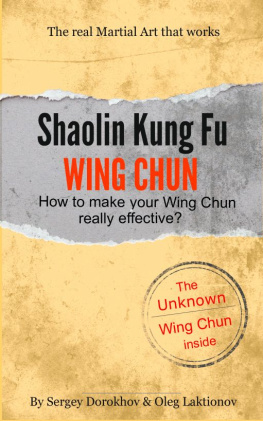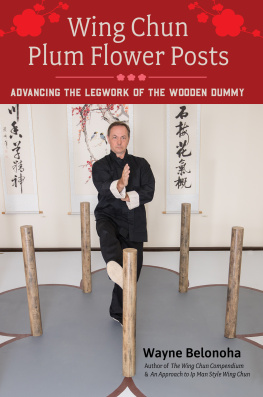Shaun has written a very interesting and detailed book on training with Wing Chun weapons. Its purpose is to share what he has learned over many years of training in Hong Kong and to provide a defined training guide on the weapons of Wing Chun. Shaun has avoided the usual this is how I do it approach and refreshingly addresses the these are the keys behind whoever does it approach in the context of best development for all.
Shaun has also managed what others have failed to do: write a clear and concise book about the weapons system of Wing Chun. I found this book goes into great depth about the purported development and original purpose of the Wing Chun weapons system as well as the modern day benefits of training the weapons and therefore will remain a great source of reference for students and instructors at all levels. It is an undertaking of great potential value, and Shaun has done it very nicely.
Between 1981 and 1985 I was undefeated World Karate Champion in forms, and in 1982 I was the first woman to be ranked number one in the United States in weapons (a feat hard to accomplish since there was no womens division and I had to compete against the men). I therefore took great interest in this publication about the Wing Chun weapons forms and it is my pleasure to provide this foreword and to recommend this book.

Fig 3 Cynthia Rothrock.
Wing Chun Kung Fu Weapons Training is not just for those beginning weapons training, it is also a good book for bringing instructors up to speed and an invaluable reference for teaching and training alike. It will not replace tuition from a certified instructor. That is not its purpose or why it was written. Rather, as with Shauns other two books, it provides a visual and descriptive reference that will serve all Wing Chun practitioners well in future learning as well as in their day-to-day training and refinement of the weapons forms.
The beginning gives a unique insight into Shauns personal and non-martial arts history and development, part of which I can attest to personally as I have known him both professionally and as a friend for twenty years. We first met when he provided close protection for me at the Martial Arts Extravaganza in 1991 and he has provided protection and accompanied me on several occasions since, as well as working with me on several photo shoots, TV and radio appearances and at martial arts demonstrations.
The largest part of the book centres on the Wing Chun butterfly knives, a complex and detailed eight section form, whose techniques are derived from the empty hand techniques of Wing Chun. Each section is detailed pictorially and described in detail. There is an in-depth description of the Wing Chun knives as well as the benefits gained from practising the form. This section then discusses in detail each key movement within each of the sections, providing an essential checklist to each key technique as well as detailing the original reasons for and benefits of training each section of the form.
The final part focuses on the Wing Chun long pole, which, though not originally part of the Wing Chun system, seems to have been taught in a knowledge exchange many years ago and adopted into the system ever since. Though this is a much shorter, simpler form than the knife form, owing to the limitations of the weapon and its reason for development within the Wing Chun system, there is still a vast amount of information regarding its development and the benefits of training the form. Again, each movement is clearly described and illustrated.
I enjoyed the book and found it gave a valuable and informative insight into the weapons training of the Wing Chun system. I know you will too. Enjoy!
Cynthia Rothrock
198185 undefeated World
Karate Forms Champion
198185 Weapons Champion
Black Belt Hall of Fame
December 2011
There are many individuals who have influenced my Wing Chun either directly or indirectly over the years and to whom I owe an acknowledgement of appreciation. These include Joseph Cheng, who inspired me, Brian Hook, who provided me with a good solid technical grounding in Wing Chun, Stephen T. K. Chan, Simon Lau and Samuel Kwok, all of whom spent time honing and guiding my skills in the UK, and my friends Trevor Jefferson, Martin Brierley and Garry McKenzie.
In Hong Kong I have been fortunate to have had the opportunity to meet and discuss Wing Chun with numerous Wing Chun Sifus, including Ip Ching, Wong Shun Leung, Chu Shong Tin, Siu Yuk Men, Lok Yiu, Leung Ting and many, many others.
I am equally grateful for the many hours I have spent discussing and practising Wing Chun with my Kung Fu brothers, all of whom have greatly assisted in the development of my Wing Chun: particularly Lo Tak On (Raymond), Leung Cheung Wai, Ho Po Kai, Leung Ting Kwok (Patrick) and Steve Cheung in Hong Kong; Yip Pui (Terence) in the USA, Ludo Delaloye in Switzerland and Colin Ward, Kwok Cheung, John Brogden, Carl Stanley and Brian Desir in the UK. I thank you all and offer my apologies to those I have not named, but your time and assistance will always be appreciated.
The individual who has had the greatest influence on my Wing Chun training and teaching, however, as well as on me as a person, is my Sifu and mentor, Ip Chun. He saw and drew out my potential, influenced my thinking and directed my approach to both training and teaching. His patience, humility, understanding and wisdom are an inspiration to myself and to all those who are fortunate enough to know and train with him; he is truly a scholar and a gentleman. Ip Chun Sifu opened my eyes to Wing Chun training and teaching and gave my Wing Chun perspective, focus and meaning. In Sifu I found a mentor, teacher and friend who was willing to spend his free time practising and discussing Wing Chun during my frequent trips to his Hong Kong home. There are no words that can truly express my respect, admiration and thanks. I would also like to thank his wife, Si-Mo, for quietly and graciously accepting the many evenings I trained in their living room until late at night, and for providing me with many needed cups of Bo Lei Cha.















